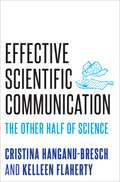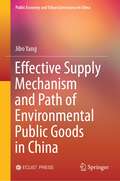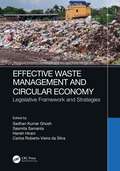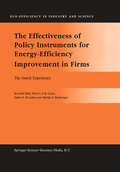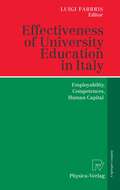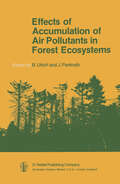- Table View
- List View
Effective Scientific Communication: The Other Half of Science
by Cristina Hanganu-Bresch Kelleen FlahertyWriting and the sciences are intricately linked. Without writing, science would not exist -- and could not be funded, communicated, replicated, enhanced, or applied. Further, writing helps scientists (and students) understand the science, explain the results of research in a greater context, and develop new ideas. Working from this philosophy, this book primarily addresses undergraduate STEM majors and minors who want or need to improve their scientific writing skills. Grounded in the basics of rhetorical research and scientific writing practices and guided by the authors' experiences in the classroom, this book makes the case that writing is an essential component of science regardless of the stage of the scientific process, and that it is in fact a component of thinking about science itself. Featuring student-centered stories that place each topic in context and suggestions for practice, Hanganu-Bresch and Flaherty arm STEM students with the skills to enhance critical thinking and cultivate good writing habits.
Effective Scientific Communication: The Other Half of Science
by Cristina Hanganu-Bresch Kelleen FlahertyWriting and the sciences are intricately linked. Without writing, science would not exist -- and could not be funded, communicated, replicated, enhanced, or applied. Further, writing helps scientists (and students) understand the science, explain the results of research in a greater context, and develop new ideas. Working from this philosophy, this book primarily addresses undergraduate STEM majors and minors who want or need to improve their scientific writing skills. Grounded in the basics of rhetorical research and scientific writing practices and guided by the authors' experiences in the classroom, this book makes the case that writing is an essential component of science regardless of the stage of the scientific process, and that it is in fact a component of thinking about science itself. Featuring student-centered stories that place each topic in context and suggestions for practice, Hanganu-Bresch and Flaherty arm STEM students with the skills to enhance critical thinking and cultivate good writing habits.
Effective Spacetime: Understanding Emergence in Effective Field Theory and Quantum Gravity
by Karen CrowtherThis book discusses the notion that quantum gravity may represent the "breakdown" of spacetime at extremely high energy scales. If spacetime does not exist at the fundamental level, then it has to be considered "emergent", in other words an effective structure, valid at low energy scales. The author develops a conception of emergence appropriate to effective theories in physics, and shows how it applies (or could apply) in various approaches to quantum gravity, including condensed matter approaches, discrete approaches, and loop quantum gravity.
Effective Supply Mechanism and Path of Environmental Public Goods in China (Public Economy and Urban Governance in China)
by Jibo YangThis book, from the perspectives of the spatial and intergenerational externalities of environmental public goods, provides a comprehensive overview of the concepts and theories concerning environmental public goods supply and illustrates how to design the mechanism for promoting resident participation in effective environmental public goods supply under the guidance of the government. Noticeably, an intergenerational overlapping model for resident participation in environmental public goods supply has been created in the book, which generates new ideas for mitigating the long-standing forward intergenerational goods shortage. Moreover, this book uses happiness dataset to measure the feasibility of resident participation in environmental public goods supply and also makes a comparison between two supply models: Government Provide Model and Residents, Enterprises and Government Provide Model, so as to offer theoretically feasible suggestions.Not only is this book highly recommended for professionals in government units, universities, and research institutions that are engaged in environmental governance, but it can be used as a reference book for students of relevant majors in institutions of higher learning.
Effective Surveillance for Homeland Security: Balancing Technology and Social Issues
by Francesco Flammini Roberto Setola Giorgio FranceschettiEffective Surveillance for Homeland Security: Balancing Technology and Social Issues provides a comprehensive survey of state-of-the-art methods and tools for the surveillance and protection of citizens and critical infrastructures against natural and deliberate threats. Focusing on current technological challenges involving multi-disciplinary prob
Effective Technology Tools for School Leadership: Understanding Digital and Data-Driven Strategies
by Leslie Jones Eugene KennedyThis book prepares educational leaders with the knowledge needed to critically evaluate, select, and use technological tools to be effective school leaders. Authors Jones and Kennedy explore the technology tools needed to support the full range of responsibilities of a school leader, including management and administration, personnel and evaluation, security and safety, instructional leadership, organizational culture and climate, external relationships, and action research. Each chapter unpacks advantages and pitfalls of various technological tools and includes case scenarios that contextualize these ideas for readers. Chapter content is also aligned with The Professional Standards for Educational Leaders (PSEL), the National Educational Leadership Preparation Standards (NELP), and the International Society of Technology Standard in Education (ISTE) standards. This timely and important book adds to the toolbox for educators preparing to become effective and cutting-edge school leaders.
Effective Technology Tools for School Leadership: Understanding Digital and Data-Driven Strategies
by Leslie Jones Eugene KennedyThis book prepares educational leaders with the knowledge needed to critically evaluate, select, and use technological tools to be effective school leaders. Authors Jones and Kennedy explore the technology tools needed to support the full range of responsibilities of a school leader, including management and administration, personnel and evaluation, security and safety, instructional leadership, organizational culture and climate, external relationships, and action research. Each chapter unpacks advantages and pitfalls of various technological tools and includes case scenarios that contextualize these ideas for readers. Chapter content is also aligned with The Professional Standards for Educational Leaders (PSEL), the National Educational Leadership Preparation Standards (NELP), and the International Society of Technology Standard in Education (ISTE) standards. This timely and important book adds to the toolbox for educators preparing to become effective and cutting-edge school leaders.
Effective Technology Transfer Offices: A Business Model Framework (SpringerBriefs in Business)
by James A. Cunningham Brian Harney Ciara FitzgeraldCombining best practices, empirical studies and the authors’ own research on technology transfer offices (TTOs), technology transfer, ecosystems and scientists in the principal investigator role, this book presents a business model framework for TTOs. From a practitioner’s perspective the business model framework captures key elements of TTOs’ strategic and operational activities that are needed for effective management and leadership. Moreover, the frameworkaddresses central issues including strategy, organisational structure, staff and resources, activities, mechanisms, policy and procedures, and evaluation and outcomes, while also consideringcontextual factors that directly and indirectly affectTTOs, namely thecommercialisation culture and ethos,as well as researchers’ commitment, awareness and motivation. For each element of the framework, the book outlines the key success factors and facilitating factors that enable effective technology transfer.
Effective Theories in Physics: From Planetary Orbits to Elementary Particle Masses (SpringerBriefs in Physics)
by James D. WellsThis open access book…There is significant interest in the Philosophy of Science community to understand the role that "effective theories" have in the work of forefront science. The ideas of effective theories have been implicit in science for a long time, but have only been articulated well in the last few decades. Since Wilson's renormalization group revolution in the early 1970's, the science community has come to more fully understand its power, and by the mid-1990's it had gained its apotheosis. It is still one of the most powerful concepts in science, which has direct impact in how one thinks about and formulates theories of nature. It is this power that this Brief sets out to emphasize through historical analysis and current examples.This is an open access book.
Effective Waste Management and Circular Economy: Legislative Framework and Strategies (The Circular Economy in Sustainable Solid and Liquid Waste Management)
by Sadhan Kumar Ghosh Sasmita Samanta Harish Hirani Carlos Roberto Vieira Da SilvaEffective Waste Management and Circular Economy: Legislative Framework and Strategies is an invaluable resource for researchers, policymakers, implementers and PhD, graduate and Under Graduate level students in universities and colleges analysing the legal framework, strategies in waste management, circular economy adoption, use of mathematical and statistical modelling in setting waste management strategies, sanitation and Hygiene in waste management. While huge wastes are wasted by dumping, there is potential of resource circulation by enforcing legislative framework to effective resource utilisation and creating business opportunities. Circularity of resources in waste streams can contribute to a more secure, sustainable, and economically sound future through the followings: Effective legal framework, strategies and policy instruments, Adoption of circular economy and recycling technologies, Support of IoT and appropriate decision making and modelling, Adoption of alternatives to plastics and other hazardous materials, Economic feasibility as business case, commercialisation, generating employment. This book addresses most of the above issues in a lucid manner by experts in the field from different countries, which are helpful for the related stakeholders, edited by experts in the field.Sadhan Kumar Ghosh, Professor at Jadavpur University, internationally well-known expert working in varied interdisciplinary fields including waste management having research collaboration in 40 countries.Sasmita Samanta, Pro-Vice Chancellor, KIIT Deemed to be University, Bhubaneswar, Odisha, India having research experience in management & academic administration.Harish Hirani, Director at CSIR-CMERI, Durgapur, having wider fields of research in IIT Delhi with a number of research collaboration.Carlos RV Silva Filho, Director, Presidente, ABRELPE, Sao Paulo/SP - Brazil & Presidente, International Solid Waste Association, Netherlands has experience of working in number of international projects
Effective Waste Management and Circular Economy: Legislative Framework and Strategies (The Circular Economy in Sustainable Solid and Liquid Waste Management)
by Dr Sasmita Samanta Dr Harish Hirani Mr Carlos Roberto Vieira Da Silva Filho Dr Sadhan Kumar GhoshEffective Waste Management and Circular Economy: Legislative Framework and Strategies is an invaluable resource for researchers, policymakers, implementers and PhD, graduate and Under Graduate level students in universities and colleges analysing the legal framework, strategies in waste management, circular economy adoption, use of mathematical and statistical modelling in setting waste management strategies, sanitation and Hygiene in waste management. While huge wastes are wasted by dumping, there is potential of resource circulation by enforcing legislative framework to effective resource utilisation and creating business opportunities. Circularity of resources in waste streams can contribute to a more secure, sustainable, and economically sound future through the followings: Effective legal framework, strategies and policy instruments, Adoption of circular economy and recycling technologies, Support of IoT and appropriate decision making and modelling, Adoption of alternatives to plastics and other hazardous materials, Economic feasibility as business case, commercialisation, generating employment. This book addresses most of the above issues in a lucid manner by experts in the field from different countries, which are helpful for the related stakeholders, edited by experts in the field.Sadhan Kumar Ghosh, Professor at Jadavpur University, internationally well-known expert working in varied interdisciplinary fields including waste management having research collaboration in 40 countries.Sasmita Samanta, Pro-Vice Chancellor, KIIT Deemed to be University, Bhubaneswar, Odisha, India having research experience in management & academic administration.Harish Hirani, Director at CSIR-CMERI, Durgapur, having wider fields of research in IIT Delhi with a number of research collaboration.Carlos RV Silva Filho, Director, Presidente, ABRELPE, Sao Paulo/SP - Brazil & Presidente, International Solid Waste Association, Netherlands has experience of working in number of international projects
Effective Writing Strategies for Engineers and Scientists
by Donald C. WoolstonThis easy-to-read, concise book is filled with examples, hints, reminders and reviews designed to help engineers and scientists develop effective writing skills. Use the book to learn to write better reports, memos, and journal articles and keep it close at hand when you have questions about organization, clarity and style, writing and revising rough drafts, graphics, workplace writing, computers in writing, and legal issues in writing. The book also contains four helpful appendices on common errors, equations and abbreviations, preparing manuscripts for publication, and documenting information sources. Effective Writing Strategies for Engineers and Scientists provides easy training for the type of writing required of engineers and scientists, gives specific advise for conveying complicated information, and describes how to synthesize information according to specific writing strategies. It is a "must" for every scientist's and engineer's bookshelf.
Effective Writing Strategies for Engineers and Scientists
by Donald C. WoolstonThis easy-to-read, concise book is filled with examples, hints, reminders and reviews designed to help engineers and scientists develop effective writing skills. Use the book to learn to write better reports, memos, and journal articles and keep it close at hand when you have questions about organization, clarity and style, writing and revising rough drafts, graphics, workplace writing, computers in writing, and legal issues in writing. The book also contains four helpful appendices on common errors, equations and abbreviations, preparing manuscripts for publication, and documenting information sources. Effective Writing Strategies for Engineers and Scientists provides easy training for the type of writing required of engineers and scientists, gives specific advise for conveying complicated information, and describes how to synthesize information according to specific writing strategies. It is a "must" for every scientist's and engineer's bookshelf.
Effectiveness of Bank Filtration for Water Supply in Arid Climates (IHE Delft PhD Thesis Series)
by Ahmed Ragab MahmoudIn many developing countries, water demand is increasing while surface- and groundwater resources are threatened by pollution and overexploitation. Hence, a more sustainable approach to water resources management and water treatment is required. In this capacity, bank filtration is a natural treatment process that makes use of the storage and contaminant attenuation capacity of natural soil/rock. However, BF is site-specific and a significant knowledge gap exists regarding the design and management of bank filtration systems, particularly in developing countries. This research aimed to address these gaps and contribute to the transfer of bank filtration to developing countries. This study comprised both column and batch laboratory-scale experiments to determine the effect of environmental variables such as temperature, raw water organic composition and redox conditions on the removal of chemical pollutants such as organic matter, micro-pollutants and heavy metals as well as the mobility of iron, manganese and arsenic under anaerobic conditions. Ultimately, the effectiveness of BF for supplying high drinking water quality was assessed in a case study in Egypt. The study showed that more than 80% of biodegradable organic matter was removed during infiltration at temperatures between 20 and 30 °C. However, humic compounds enriched during BF, required post-treatment. Moreover, high humic content of infiltrating water reduced the removal of heavy metal and promoted the release of metal (loids) into the infiltrating water, rendering it more feasible to install BF wells within surface water systems with low levels of organic matter. Moderately-hydrophobic organic micropollutants were most persistent and required infiltration times longer than 30 days for complete elimination even at high temperatures (>20 °C). Finally, design parameters such as the number of infiltration wells should be configured to minimise the proportion of polluted groundwater in the pumped water. Overall, this study provides insight into the effectiveness of BF in removing chemical pollutants from surface water and proposes guidelines for the successful application of BF in developing countries where arid conditions and high temperatures prevail.
Effectiveness of Bank Filtration for Water Supply in Arid Climates (IHE Delft PhD Thesis Series)
by Ahmed Ragab MahmoudIn many developing countries, water demand is increasing while surface- and groundwater resources are threatened by pollution and overexploitation. Hence, a more sustainable approach to water resources management and water treatment is required. In this capacity, bank filtration is a natural treatment process that makes use of the storage and contaminant attenuation capacity of natural soil/rock. However, BF is site-specific and a significant knowledge gap exists regarding the design and management of bank filtration systems, particularly in developing countries. This research aimed to address these gaps and contribute to the transfer of bank filtration to developing countries. This study comprised both column and batch laboratory-scale experiments to determine the effect of environmental variables such as temperature, raw water organic composition and redox conditions on the removal of chemical pollutants such as organic matter, micro-pollutants and heavy metals as well as the mobility of iron, manganese and arsenic under anaerobic conditions. Ultimately, the effectiveness of BF for supplying high drinking water quality was assessed in a case study in Egypt. The study showed that more than 80% of biodegradable organic matter was removed during infiltration at temperatures between 20 and 30 °C. However, humic compounds enriched during BF, required post-treatment. Moreover, high humic content of infiltrating water reduced the removal of heavy metal and promoted the release of metal (loids) into the infiltrating water, rendering it more feasible to install BF wells within surface water systems with low levels of organic matter. Moderately-hydrophobic organic micropollutants were most persistent and required infiltration times longer than 30 days for complete elimination even at high temperatures (>20 °C). Finally, design parameters such as the number of infiltration wells should be configured to minimise the proportion of polluted groundwater in the pumped water. Overall, this study provides insight into the effectiveness of BF in removing chemical pollutants from surface water and proposes guidelines for the successful application of BF in developing countries where arid conditions and high temperatures prevail.
The Effectiveness of European Union Environmental Policy
by W. Grant D. Matthews P. NewellSeveral hundred directives on environmental policy have been produced by the European Union. What impact has the output of the 'legislative factory' had? After considering how decisions on environmental policy in the EU are made, and the balance of power between business and environmental interests, this book draws on the specialist expertise of the authors to look in depth at the areas of global warming, water pollution and air pollution.
The Effectiveness of Neurofeedback Training for Children with Autism Spectrum Disorders (BestMasters)
by Franziska EllerFranziska Eller investigated the effectiveness of individualized Neurofeedback training in addition to a comprehensive basic neurodevelopmental therapy for children with Autism Spectrum Disorders (ASD). The results clearly speak for the benefits of a supplemental Neurofeedback training, since QEEG recordings revealed positive changes in the children’s brain wave activity after only a few weeks of training. Furthermore behavioral aspects and imitation abilities were assessed using two autism questionnaires and an imitation test. Results showed that all children improved in several domains, with the treatment group partly achieving greater changes than the control group. Unlike the most prevalent therapy methods that are mainly behavior-based, Neurofeedback training aims at improving abnormal brain wave activity and thereby establishes an alternative, promising approach to treat Autism Spectrum Disorders.
The Effectiveness of Policy Instruments for Energy-Efficiency Improvement in Firms: The Dutch Experience (Eco-Efficiency in Industry and Science #15)
by Kornelis Blok Henri L.F. de Groot Esther E.M. Luiten Martijn G. RietbergenHow can governments stimulate energy-efficiency improvement? This book analyzes environmental policy in the Netherlands to present a wealth of empirical results on the successes and failures of governmental initiatives in environmental policy. Discussion extends to such topics as free-rider effects of subsidies, the credibility of voluntary agreements, the art of regulation and the fate of research & development money.
Effectiveness of Protected Areas in Conserving Biodiversity: A Worldwide Review (Strategies for Sustainability)
by David Rodríguez-Rodríguez Javier Martínez-VegaThis book addresses the effectiveness of existing protected areas at conserving the diversity of genes, species and ecosystems on land and at sea. The book synthetizes the main biodiversity conservation outcomes of protected areas in the 2010-2019 decade, drawing on a systematic literature review of scientific publications and case studies from around the world demonstrating successes and failures. It provides region-specific results for land and sea ecosystems as well as for developed and developing countries. It also reviews current methodological approaches used to assess protected area effectiveness. The work is timely, since there is growing concern on the global biodiversity crisis among researchers, government organizations and the general public, as demonstrated by the 2030 targets established by the UN Sustainable Development Goals for Life Below Water (SDG 14) and Life On land (SDG15). The book is written in an easy and enjoyable style using numerous pictures, tables and graphs to make the content more engaging and understandable. The main intended audiences of the book are academics, from post-graduate students to university lecturers, and senior researchers in the fields of biodiversity conservation, sustainable development and environmental policy, as well as protected area managers and practitioners.
Effectiveness of University Education in Italy: Employability, Competences, Human Capital
by Luigi FabbrisIn this volume – drawn on experience at Italian universities – the authors infer upon the quality of the education achieved by graduates by surveying their transition to work and further professional paths. Papers are presented on the effectiveness of university education, on employability of graduates, with a discussion on considering the employment rate as the main assessment indicator, on competence analysis for backward assessment purposes and finally on university human capital indicators.
Effector-Triggered Immunity: Methods and Protocols (Methods in Molecular Biology #2523)
by Thomas A. Kufer Maria Kaparakis-LiaskosThis volume presents a collection of protocols to study effector-triggered immunity (ETI) in both plants and animals from eminent groups in the field. The chapters in this book cover topics such as genetic manipulation of plant and animal pathogens, host cells, and the analysis of key host responses; and techniques used for the analysis of inflammasome activation, cell death pathways, and mitochondria damage in response to pathogens. All of these topics cover a broad spectrum of immunological, biochemical, cell biological, and structural biology approaches to examine ETI. Written in the highly successful Methods in Molecular Biology series format, chapters include introductions to their respective topics, lists of the necessary materials and reagents, step-by-step, readily reproducible laboratory protocols, and tips on troubleshooting and avoiding known pitfalls.Cutting-edge and practical, Effector-Triggered Immunity: Methods and Protocols is a valuable resource for both expert and novice researchers who are interested in learning more about the important and developing field of ETI.
Effectors in Plant-Microbe Interactions
by Francis Martin Sophien KamounPlants and microbes interact in a complex relationship that can have both harmful and beneficial impacts on both plant and microbial communities. Effectors, secreted microbial molecules that alter plant processes and facilitate colonization, are central to understanding the complicated interplay between plants and microbes. Effectors in Plant-Microbe Interactions unlocks the molecular basis of this important class of microbial molecules and describes their diverse and complex interactions with host plants. Effectors in Plant Microbe Interactions is divided into five sections that take stock of the current knowledge on effectors of plant-associated organisms. Coverage ranges from the impact of bacterial, fungal and oomycete effectors on plant immunity and high-throughput genomic analysis of effectors to the function and trafficking of these microbial molecules. The final section looks at effectors secreted by other eukaryotic microbes that are the focus of current and future research efforts. Written by leading international experts in plant-microbe interactions, Effectors in Plant Microbe Interactions, will be an essential volume for plant biologists, microbiologists, pathologists, and geneticists.
Effectors of Thermogenesis: Proceedings of a Symposium held at Geneva (Switzerland) on 14 to 16 July 1977 (Experientia Supplementum #32)
by Girardier LucienOne of the most interesting aspects of thermogenesis research is that it quite naturally attracts workers from an extremely wide spectrum of interests, ranging from the mechanism of cellular respiratory control at the molecular level and neuro-hormonal control of energy dissipation both at the cellular level and that of the whole organisms to the mechanism of temperature control during the hibernating cycle and that of cold acclimatation. Thus, the Satellite Symposium on "The Effectors of Thermogenesis" brought together not only physiologists, but also biochemists, pharmacologists, zoologists and clinicians, and provided a forum for the airing of new ideas as well as for the confrontation of different points of view. These are now reproduced in this book in exactly the same form and order in which they were presented at the Symposium, in the hope of providing a bird's-eye view of the various facets of thermogenesis research. A "mini-review", summarizing the current knowledge in each domain, therefore precedes the corresponding papers. The editors are deeply indebted to the contributors of these introductory lectures for so competently selecting from the mass of available information in each field, only the most essential elements. This book is dedicated to Dr. Robert Emrie Smith, a pioneer and path-finder in this field, who organized the first meeting on thermogenesis as a satellite of the XXI International Congress of Physiological Sciences and took an active part in the four subsequent meetings. L. Girardier DEDICATION Dr.
Effects of Accumulation of Air Pollutants in Forest Ecosystems: Proceedings of a Workshop held at Göttingen, West Germany, May 16–18, 1982
by B. Ulrich and J. PankrathThis volume is based on a workshop on "Effects of accumulation of air pollutants in forest ecosystems'; held in GOttingen, Federal Republic of Germany, from May 16-18, 1982. This work'shop was initiated and sponsored by the Environmental Agency of the Federal Republic of Germany (project officer: Dr. J. Pankrath) as part of a research contract (project leader: Dr. B. Ulrich). THE PROBLEM SEEN UNDER THE ASPECT OF ADMINISTRATION The problem of forest damage caused by air pollution is not new in Europe. Already in 1983 a comprehensive report from Schroeder and Reuss about vegetation damages by fume in the Harz mountains was published. In 1923, Prof. Dr. Julius Stocklasa of the Bohemian Technical Highschool in Prague was concerned with research of toxical effects of sulphur dioxide in his publication "The damage of vegetation by flue gas and exhalations of facili ties". This comprehensive and instructive work concludes with the sentence: "It is already high time for the governments of all cultural states to take legal, police and private measures in order to prevent damage by flue gases". In the neighbourhood of industries with high gaseous and dust emissions damages have been shown to occur for a long timei these deleterious effects have influenced the growth of trees and in extreme cases have even caused their early death.
Effects of Acid Precipitation on Terrestrial Ecosystems (Nato Conference Series #4)
by Thomas C. Hutchinson M. HavasThis volume contains papers presented at a NATO Advanced Research Institute, sponsored by their Eco-Sciences Panel, on "The effects of acid precipitation on vegetation and soils," held at Toronto, Canada from May 22-26, 1978. The organizing expenses and greater part of the expenses of the speakers and chair~en were provided by N.A.T.O. The scientific programme was planned by T. C. Hutchinson together with an international planning committee of G. Abrahamsen (Norway), G. Likens (U.S.A.), F.E. Last (U.K.), C.O. Tamm (Sweden) and B. Ulrich (W. Germany). Many of the dimensions of the 'acid rain' problem are common to countries of northern Europe and North America. The developing awareness over the past ten years of the international nature of the acid rain phenomenon has lead to studies documenting damaging effects on susceptible freshwater bodies. Large areas of the Canadian Pre-Cambrian Shield, with its extension into the United States, and the granitic areas of southern Norwayand Sweden contain lakes which are in the process of acidification. The biological resources of these affected areas are of considerable national concern. However, while clearly damaging effects of acidification on freshwater systems have been well documented, the impact of acid precipitation on terrestrial systems has not been so well understood.
